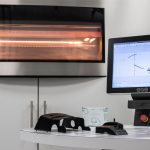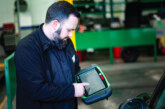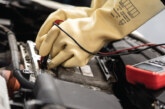Mercedes-Benz prints metal truck part
Mercedes-Benz Trucks has produced the first printed truck spare part made of metal: a thermostat cover for older truck and Unimog models. The part has been subject to and passed all the usual stringent quality control processes that apply to conventionally produced parts, says the company.
The rarely-ordered aluminium parts now being 3D-printed have almost 100% density and greater purity than conventional die-cast aluminium parts, says Mercedes.
Metal parts from the 3D printers have very high strength and thermal resistance, it points out, so the process is particularly suitable for production of mechanically and thermally stressed components. It says other potential components suitable for the process could be peripheral metal engine parts, in-engine parts and also parts in cooling systems, transmissions, axles or chassis.
Metal parts are produced using the Selective Laser Melting (SLM) process. In the case of the thermostat cover, the powdered aluminium/silicon material (ALSi10Mg) is applied in individual layers and melted by an energy source — usually one or more lasers. When one layer is completed, a new layer of powder is applied automatically and the melting process is repeated.
The process is repeated until a high- strength, three-dimensional aluminium component suitable for use in areas of high temperature has been produced. Thanks to the layered structure, the process also offers a level of geometrical freedom that cannot be matched by any other production method.
If you’ve heard about 3D printing, it’s probably for on-the-spot creation of toys and characters from animation films. However, 3D printing is set to go mainstream and aftermarket parts is one sector where it is predicted to be game-changer, as CVW ’s Sharon Clancy investigates.
One of the key benefits claimed for 3D printing is that it will simplify the aftermarket supply chain. As buyers of spare parts and valued customers, vehicle operators will be at the centre of this transformation of the aftermarket parts supply business – assuming it happens, of course. Because, despite all the hype, non-one is quite sure exactly what impact 3D printing will have.
The UK parts aftermarket is already one of the slickest in Europe. Workshops can order goods by 8pm or even later and get overnight delivery. Vast sums have been invested by the vehicle manufacturers and parts suppliers in systems that ensure the right part is in the right place – all to minimise VOR time. Given the huge sums already invested in stock and spares management, can 3D printing make an impact? Well, while a 3D printer in the back of the parts van is unlikely to become a reality for a couple of decades, it seems 3D printing might find a niche much quicker.

What is 3D printing?
3D printing is the catchy name for a production process called Additive Layer Manufacturing (ALM). The 3D printing process adds thin layers of melted plastic, aluminium, and powders together to form the required shape. It knows the shape to print thanks to a digital file or software that is uploaded to the printer.
The three main ones are Selective Laser Sintering (SLS), Selective Laser Melting (SLM) and Fused Filament Fabrication (FMM). SLS is used mainly for plastics parts and SLM for metal ones.
Where could it be used?
Typical scenarios where 3D printing could be transformative include:
■ Customised parts and obsolete parts which are not easily available or are excessively expensive.
■ Low-volume parts. For low-volume parts where production runs remain costly.
■ Mission-critical service operations: For roadside breakdowns, for example, where first-time fix rates are a critical KPI.
■ Reduced inventory. Matching parts volumes to demand is an inexact science, which can lead to excessive stock simply to ensure customer service levels are maintained. 3D printing close to the demand can help resolve this dilemma.

What’s holding 3D printing back?
A survey by research company PwC Strategy earlier this year identified some key issues to resolve.
■ Cultural and skill challenges. For automotive parts suppliers, it’s quite a shift from traditional, centralised, manufacturing processes to localised 3D printing.
■ Printer and material costs. Technology is still advancing – current 3D printers are quite small, for example, so often additional post- print treatment steps are needed. Print speed is also an issue and, to date, there are no standards for 3D printing processes or materials.
■ Complexity. Complex parts take time to print, so 3D printing won’t suit high-volume parts manufacturing. Some parts are manufactured to tight tolerances which a 3D printer may not be able to replicate.
■ Environment. 3D printers are sensitive to environmental conditions – they need a level surface and dust-free environment.
■ Quality. Currently, there are no global standards for 3D printers or materials.
■ Intellectual Property rights. For OEMs, it’s about the ability to control authorisation to print a copyrighted part.










